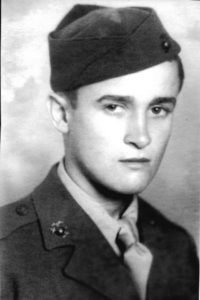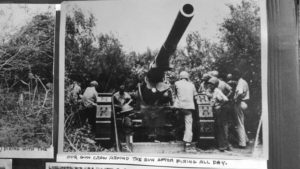by James Rada, Jr.
The Living History of Chuck Caldwell
 Chuck Caldwell and his father, George, came to Gettysburg, Pennsylvania, on the last day of June 1938 for the 75th anniversary of the Battle of Gettysburg. The town decorated with banners, bunting, and lights, and was so crowded that the Caldwells couldn’t find a room to stay in and spent their first night sleeping in a chicken coop. Chuck, who was fourteen years old, didn’t mind because he had made it to Gettysburg.
Chuck Caldwell and his father, George, came to Gettysburg, Pennsylvania, on the last day of June 1938 for the 75th anniversary of the Battle of Gettysburg. The town decorated with banners, bunting, and lights, and was so crowded that the Caldwells couldn’t find a room to stay in and spent their first night sleeping in a chicken coop. Chuck, who was fourteen years old, didn’t mind because he had made it to Gettysburg.
Chuck and his father visited the Veterans’ Camp, which had been constructed on the north end of Gettysburg College and some adjacent private property. Union Veteran tents were located on lettered streets, from Biglerville Road to Mummasburg Road. Confederate Veteran tents lined numbered streets, from Mummasburg Road to the Reading Railroad. Only about 2,000 Veterans had made it to the reunion, although tens of thousands more people were in town.
“It was a thrill to be able to see both armies together at one time,” Chuck said. “It was just too much. I would have walked from home to be there.”
When Chuck met a Veteran, he would get the man to sign his autograph book and write down his hometown and unit. Chuck also had his picture taken with the Veteran. Chuck later added some flourishes, such as a Union or Confederate flag. When he was finished, he had nearly fifty autographs in the book.
It’s a priceless piece of history that he still cherishes.
A Talent For Art
Chuck was born in Princeton, Illinois, in 1923. Because his father was a minister, the Caldwells moved from town to town each time he took a new job. Although both Chuck’s father and grandfather were clergymen, Chuck didn’t want to follow in their footsteps. That was obvious from a young age.
“I was a pew climber in church,” Chuck said. “I just wouldn’t sit still.”
With George preaching at the front of the church, it fell to Ellen Caldwell to keep her ears open to the sermon and her eyes on young Chuck, as he would crawl over, under, and across the pews, disturbing nearby churchgoers.
His mother finally stopped trying to make her son sit down. Instead, she gave Chuck paper and a pencil and let him draw, hoping to focus his attention elsewhere.
It worked. Chuck became so focused on creating something on the sheet of paper that the only part of him moving during the service was his hand. He still wasn’t listening to the sermons, but at least he wasn’t disturbing everyone around him.
Chuck won his first art competition at the 1940 Wayne County Ohio Hobby Exposition, with a diorama of the railyard scene in Gone With the Wind. The display featured four hundred different clay figures, in addition to the ones he had drawn into the background scenery. The piece was so popular that a local department store displayed it in their window to help attract customers.
Becoming a Marine
Chuck wasn’t large enough to play football, but he was a huge fan of the game, especially the University of Alabama team. Because of this, Alabama was his only choice for college when he graduated high school in 1941. He even became the freshman football team manager.
“I got picked on by the players because I was small. It was all right, though, because I was part of the team. I was part of the Great Crimson Tide.”
Chuck worked hard and long hours. Unfortunately, most of that time was spent with the football team. As Chuck grew skeptical about his chances of passing his classes, he decided that he needed a plan in case he wouldn’t be returning to the university after the Christmas break.
On December 1, he enlisted in the U.S. Marine Corps. All that was left for him to do was to pass his final physical. He arranged it so that he wouldn’t be inducted until after Christmas.
On Sunday, December 7, Chuck was actually studying when his roommate rushed into the room shouting that the Japanese had bombed Pearl Harbor. Chuck was stunned. He knew from his roommate’s tone that something was wrong, but he wasn’t quite sure what.
“Where’s Pearl Harbor?” Chuck asked.
They had to dig out an atlas to locate Pearl Harbor.
As the realization settled on Chuck that the Japanese had attacked the United States and that the two countries were now at war, Chuck’s first thought was that he now had an excuse to do poorly on his exams. Then as he realized what he was thinking, he felt shame.
Chuck left school on December 15, without even taking his finals. It didn’t matter now. He headed home on the train to tell his parents that he was going to be a Marine.
The physical at the end of December was quick and basic. The minimum requirement for Marines at the time was that they weigh at least 120 pounds and stand at least five feet six inches tall. Chuck became a Marine by one pound and half an inch.
He made it through five weeks of basic training at Parris Island, South Carolina, and shipped out to New Zealand, knowing that he was going to be fighting in the war.
“I wasn’t scared,” Chuck said. “I was going to take part in real history.”
WWII
Chuck’s early months in the Pacific involved a lot of sailing, from one island to another, but then on November 2, 1942, he landed on Guadalcanal to reinforce a group of Marines who had been fighting the entrenched Japanese for weeks.
He spent the next five months on the island, fighting occasionally, and dodging bombs from almost daily air raids. Japanese bombers would fly from ships surrounding the island to drop their bombs. The goal was to destroy the runway on Henderson Field, in the hopes of keeping the Marines on the ground.
The raids kept the Marines’ nerves on edge, especially at night when they couldn’t see the planes coming.
Some mornings, they would find odd footprints from people wearing tabis in camp. These were Japanese tennis-shoe-type boots that separated the big toe from the rest of the toes. Chuck realized that the footprints meant that the Japanese had come through their camp unseen.
“It made me think that somebody was not guarding our camp too well,” Chuck said. “That’s when I started sleeping on my back with my K-bar next to me.”
On November 14, Chuck was awakened by nearby explosions, just after midnight. The Japanese ships had turned their large guns on the island and were shelling it.
“Coconut trees were splintered and falling everywhere.”
As the shelling continued, Chuck realized that it was too heavy to stay in the foxhole. He needed to get to the air raid shelter.
He started counting how long it was between the time a gun fired and when the shell hit. The time between firing from the ship and hitting the island was consistent.
When one shell hit nearby, Chuck took off running. Apparently, one of the shells came in quicker than expected. A coconut tree exploded near Chuck, sending wood splinters into his right knee, left chest, and wrist.
Chuck yelled as he hit the ground and rolled. He saw blood, but he wasn’t feeling pain at the moment. He couldn’t rest out in the open. He got to his feet and hobbled on. He would eventually receive a Purple Heart for this wound.
Chuck eventually got off Guadalcanal, but he was transferred to the Second Division Marines and sent to Tarawa a little more than a year after he had arrived at Guadalcanal. Although the fight there was shorter, it was just as fierce as Guadalcanal.
The Marines met heavy resistance as they landed at Tarawa. They reached the beaches, but could barely hold that position. Later waves of Marines took heavy casualties even before they reached the shore. Ammunition ran low, and the Marines had to scavenge ammunition belts from the dead.
The water was chest deep as Chuck started wading ashore. He held his rifle above his head. The Japanese peppered the water with bullets.
“We lost three hundred men in 500 yards,” Chuck said.
Chuck tried to ignore the men suddenly floating face down in the water around him. He dove underwater and swam, hoping to escape the bullets splashing around him.
His job at Tarawa was to offload the ships that made it to the dock with supplies. He and the other Marines carrying supplies were popular targets for the Japanese, because they were out in the open and couldn’t fire back.
Near the end of three days of fighting and almost no sleep, Chuck collapsed. It turns out that he had contracted malaria, most likely on Guadalcanal.
He returned home for a thirty-day leave in 1944, but after another bout of malaria, he wound up extending his time. While recovering in a Navy hospital, he met Jackie Murphy, a WAVE (Women Accepted for Volunteer Emergency Service) nurse, who would eventually marry him the following year.
Nuclear Bombs
After the war ended, Chuck earned his art degree and took a job in Oak Ridge, Tennessee, designing displays for the American Museum of Atomic Energy. He eventually transferred to a different department, doing technical drawings, which turned out to be very boring.
Anxious to escape his boredom, he volunteered to spend the summers of 1957 and 1958 in Nevada, setting up atomic bomb tests and collecting data after explosions. He saw dozens of bomb detonations.
Chuck was excited to see his first atomic bomb detonation. He expected an ear-shattering explosion.
“It wasn’t that noisy, but what happened afterwards is that this doughnut rolled out from the center and knocked you on your ass if you weren’t kneeling down,” recalled Chuck.
The doughnut was the concussive force of the explosion stirring up sand as it moved outward from ground zero.
On His Own
In 1968, with four children and a wife to support, Chuck decided to strike out on his own as an artist. He quickly found work, including selling miniatures to shops in Gettysburg. The Caldwells moved to Lake Dallas, Texas, in the early 1970s, where Chuck had the promise of steady work.
Things didn’t pan out quite as he had expected, and the Caldwells decided to move to Gettysburg in 1980. Chuck came first and got his small shop in the Old Gettysburg Village established. He had been visiting the town for most of his life and was excited to finally call it home.
Over the years, he has sculpted more than 15,000 miniature soldiers, musicians, and sports figures. This doesn’t even count the thousands of even smaller figures he crafted to fill the stadium models that he built.
Jackie died in 2007, after sixty-two years of marriage, and Chuck decided that it was time for him to retire. He still makes some miniatures from his home.
At age ninety-four, Chuck is still healthy and living on his own in Gettysburg. He still visits with friends and hosts holidays for his family, which has grown to include four grandchildren and two great-grandchildren.

“Our gun crew around the gun after firing all day.” — Chuck Caldwell

